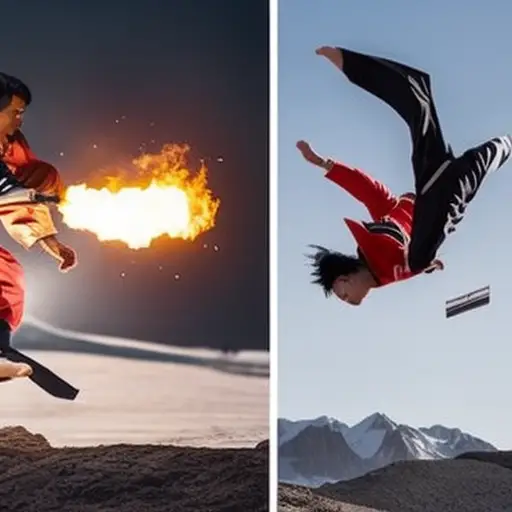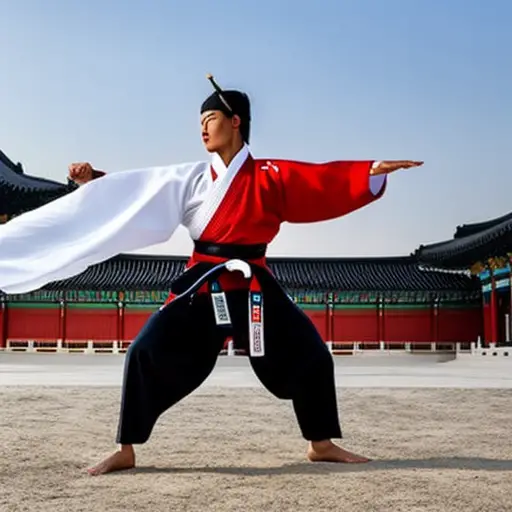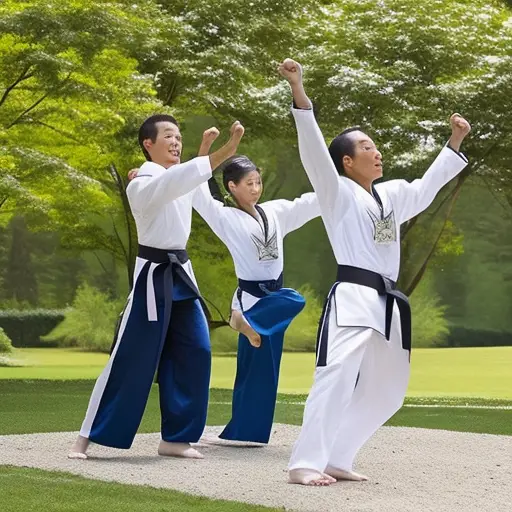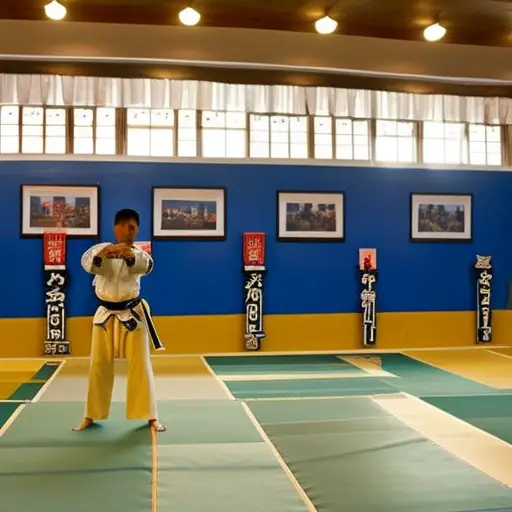Taekwondo in Movies and TV: Separating Fact From Fiction

From the iconic high-flying kicks of Bruce Lee in ‘Enter the Dragon’ to the intense training montage in ‘The Karate Kid,’ martial arts have captivated audiences for decades.
In the realm of martial arts, Taekwondo stands out as a dynamic and powerful discipline. However, its portrayal in movies and TV often blurs the line between fact and fiction.
In this article, we delve into the evolution, myths, and impact of Taekwondo in the world of entertainment, separating the thrilling truth from the choreographed spectacle.
The Evolution of Taekwondo in Film and Television
One cannot deny the significant impact that the evolution of taekwondo has had on the depiction of martial arts in film and television. Over the years, taekwondo has undergone several evolutionary changes, which have influenced how it is portrayed on the screen. These changes have not only enhanced the realism and authenticity of taekwondo fight scenes but have also contributed to a more accurate cultural representation of this Korean martial art.
In the early days of taekwondo’s appearance in film and television, the portrayal was often limited to generic martial arts scenes that lacked specificity. However, as taekwondo gained popularity globally, filmmakers and producers recognized the need to accurately showcase its unique techniques and philosophy. This led to a more detailed and precise representation of taekwondo in on-screen fight sequences.
Moreover, the evolution of taekwondo in film and television has also contributed to a better cultural representation. It has helped dispel stereotypes and misconceptions surrounding this martial art, showcasing it as a disciplined and respectful practice deeply rooted in Korean culture. By accurately representing the cultural aspects of taekwondo, filmmakers and television producers have played a crucial role in promoting understanding and appreciation for this martial art beyond its physicality.
Famous Taekwondo Scenes: Real or Choreographed
Famous taekwondo scenes in movies and TV are often a subject of curiosity, as viewers wonder whether they are real or choreographed. While some fight scenes may feature real taekwondo practitioners showcasing their skills, many are choreographed to enhance the visual impact and storytelling.
It is important to understand the distinction between real and choreographed taekwondo in these famous fight scenes.
In film and television, the primary goal is to entertain the audience, and choreographed fight scenes allow for precise movements, camera angles, and editing techniques that create a visually stunning experience. Choreographers work closely with trained martial artists to design sequences that showcase the beauty and intensity of taekwondo, while also ensuring the safety of the actors involved.
However, there are instances where real taekwondo techniques and practitioners are featured in famous fight scenes. Some actors undergo rigorous training to perform their own stunts and execute taekwondo moves with authenticity. These scenes often require close collaboration between the actors, choreographers, and taekwondo experts to ensure accuracy and realism.
In the next section, we will delve into the training techniques used in taekwondo movies and TV shows, unveiling how actors prepare to portray skilled taekwondo practitioners on screen.
Unveiling the Training Techniques of Taekwondo in Movies and TV
The training techniques utilized in taekwondo movies and TV shows involve a combination of disciplined practice and expert guidance. These techniques are carefully choreographed to create visually stunning fight scenes that captivate audiences. Here are some of the training techniques commonly seen on screen:
-
Poomsae: Taekwondo forms, known as poomsae, are a series of predetermined movements that showcase the practitioner’s skills and techniques. In movies and TV shows, these forms are often exaggerated for dramatic effect.
-
Sparring: Sparring is a crucial aspect of taekwondo training, and it is often depicted in movies and TV shows. The choreography for sparring scenes is designed to highlight the speed, agility, and precision of the fighters.
-
Board Breaking: Breaking boards is a common demonstration of power in taekwondo. On screen, board breaking is often used to showcase the protagonist’s strength and skill.
-
Weapon Training: Taekwondo practitioners also train with various weapons, such as nunchaku and swords. In movies and TV shows, weapon training sequences are choreographed to demonstrate the character’s mastery of these weapons.
Uncovering cinematic taekwondo skills and exploring taekwondo’s on-screen presence allows us to appreciate the dedication and talent of the actors and stunt performers. However, it is important to remember that these techniques are often exaggerated for entertainment purposes.
In the next section, we will delve into the stereotypes surrounding taekwondo in movies and TV and debunk some common misconceptions.
Breaking Down the Myths: Debunking Taekwondo Stereotypes on Screen
Through a critical examination of taekwondo’s representation in movies and TV, we can dispel the stereotypes and misconceptions perpetuated by these portrayals. It is important to debunk these stereotypes as they not only misinform the general public but also undermine the true essence and value of taekwondo as a martial art and sport.
One common misconception in the media is that taekwondo is solely about high-flying kicks and acrobatics. While taekwondo does emphasize kicking techniques, it also incorporates various hand strikes, blocks, and grappling moves. Furthermore, the focus of taekwondo extends beyond physical techniques to include mental discipline, self-defense skills, and personal development.
Another stereotype often portrayed is that taekwondo practitioners are all aggressive and violent individuals. In reality, taekwondo promotes self-control, respect, and humility. It teaches practitioners to avoid physical confrontations whenever possible and to use their skills responsibly.
Moreover, the media sometimes depicts taekwondo as an exclusively male-dominated activity. This is far from the truth, as taekwondo is practiced by individuals of all genders and ages. Women, in particular, have excelled in taekwondo and have made significant contributions to the sport.
The Impact of Taekwondo in the Entertainment Industry
How has taekwondo influenced the entertainment industry?
Taekwondo has had a significant impact on the entertainment industry, both in terms of cultural representation and its influence on other martial arts in movies and TV. Here are four key ways in which taekwondo has made its mark:
-
Cultural representation: Taekwondo has been portrayed in various cultures in entertainment, showcasing its global appeal. From Korean films like ‘Taekwondo’ to Hollywood blockbusters like ‘The Karate Kid,’ taekwondo has been depicted as a dynamic and powerful martial art that transcends borders.
-
Taekwondo’s influence: Taekwondo has inspired other martial arts in movies and TV, leading to the creation of new fighting styles. For example, the fast and acrobatic kicks of taekwondo have influenced the choreography of fight scenes in films like ‘The Matrix’ and ‘Crouching Tiger, Hidden Dragon.’
-
Martial arts training: Taekwondo has become a popular choice for actors and stunt performers to enhance their physical abilities and create more authentic fight sequences. Many actors, such as Tony Jaa and Scott Adkins, have trained in taekwondo and incorporated its techniques into their performances.
-
Sports entertainment: Taekwondo has gained recognition as a competitive sport in the entertainment industry. The inclusion of taekwondo in events like the Olympic Games has elevated its profile and brought it to a wider audience, further contributing to its impact in the entertainment world.
Frequently Asked Questions
How Many Movies and TV Shows Have Featured Taekwondo as a Martial Art?
Numerous movies and TV shows have featured taekwondo as a martial art, highlighting various popular techniques. The portrayal of taekwondo in media has had a significant impact on shaping the perception of martial arts among audiences.
Are the Actors in Taekwondo Scenes in Movies and TV Shows Real Taekwondo Practitioners?
The accuracy of taekwondo choreography in movies and TV greatly impacts the portrayal of martial arts in media. While some actors in taekwondo scenes may be real practitioners, it is not always the case.
What Are Some Common Misconceptions About Taekwondo in Movies and Tv?
Common misconceptions about Taekwondo in movies and TV include its effectiveness in real-life self-defense and the portrayal of high-flying kicks and acrobatics as the norm. These misconceptions perpetuate stereotypes and misrepresent the martial art.
Has the Portrayal of Taekwondo in Movies and TV Influenced Its Popularity in the Real World?
The portrayal of taekwondo in movies and TV has had a significant impact on its popularity in the real world, particularly among youth. However, there is a concern about the cultural appropriation of taekwondo in the entertainment industry.
Are There Any Notable Celebrities Who Have Trained in Taekwondo for Their Roles in Movies or TV Shows?
Celebrity taekwondo practitioners have trained in the martial art for their roles in movies and TV shows, showcasing the impact of taekwondo training on actors’ performances. Their dedication and skill contribute to the authenticity and realism of fight scenes.
Conclusion
In conclusion, the portrayal of Taekwondo in movies and TV has evolved over time, blending reality with choreography to create captivating scenes. By delving into the training techniques showcased on screen, we can separate fact from fiction and debunk common stereotypes associated with Taekwondo.
This martial art form has made a significant impact on the entertainment industry, captivating audiences worldwide. As we reflect on the influence of Taekwondo in film and television, we are left questioning the role it plays in shaping our perceptions and inspiring us to explore its rich history further.





